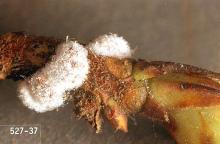Eriococcus azaleae
Pest description and crop damage This scale superficially resembles mealybugs in appearance. Mature female scale are about 0.125 inch long and appear like white cottony sacs, often located on twigs and stems of azalea, especially in branch crotches. The scale feeds on the bark of twigs and stems and has a devigorizing effect. Large quantities of honeydew are produced, which makes leaves shiny and sticky. Sooty mold fungus may grow on this, giving the plants a dirty, sooty appearance. Honeydew also can collect on decks and other landscape surfaces and become a significant nuisance.
Biology and life history The scale overwinters as an adult, and lays eggs in the spring. The young scale (called "crawlers") are the mobile form of most species, and these migrate through the foliage to feed. As they feed and mature, they form a protective shell over their bodies. Crawlers are the most vulnerable life stage of most scale species. Adults of most species are well protected from predators and pesticide applications under the protective shell which gives them their name. There is usually one or possibly two generations per year.
See:
For more information
PNW Nursery IPM: Azalea bark scale (https://agsci.oregonstate.edu/nurspest/insects/azalea-bark-scale)



